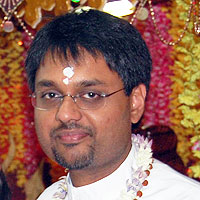From a satsang with Pt. Dr. Umesh Persad
In Sanatan Dharma, the eternal way of life, scriptures are the luminous threads that guide seekers on their journey to self-realisation and understanding. Among these scriptures, there exists a duality: the Shruti, that which has been heard by the sages, and the Smriti, that which has been remembered, nurturing the stories and sagas like the Ramaayana and Shri RamCharitmanas. At the zenith of this rich tapestry stands the Bhagavad Gita, an eternal jewel woven from the Mahabharata epic, which encapsulates the quintessence of Sanatan Dharma’s teachings.
The Bhagavad Gita‘s first chapter creates a vivid picture of a battlefield – not only the field of action called Kurukshetra, but also a theatre within the mind where life’s decisions are deliberated, the Dharmakshetra. King Dhritarashtra, a symbol of relentless materialism, seeks the vision of Sanjay to narrate the unfolding drama on the battlefield.
The battleground is an allegory, pitting two dynasties against each other: the Pandavas and the Kauravas, embodying positive and negative inclinations respectively, represent the opposing forces residing within the individual. They echo profound queries: What path should one follow? What is right and wrong? Which duality should one choose? The battle isn’t merely external; it’s a reflection of our internal conflicts.
Language itself holds the key to understanding the scriptures. Dhritarashtra, a combination of “dhrit” (adherence) and “rastra” (king), signifies a resolute grasp on the material world. His blindness mirrors the birth of negative traits embodied by his sons. Duryodhana, meaning “difficult to defeat”, which encapsulates the tenacity of negative qualities that resist elimination. His sibling, Dushasana, meaning “difficult to control”, epitomises the challenge of reigning in desires.
The battle is also a war of thoughts within the mind. It grapples with life’s decisions and our reactions to adversity as well as the battle of duality and opposite principles that exist within the mind. Arjuna and Shree Krishna’s discourse delves into this core essence. The five Pandava sons – Yudhishthira, Bhima, Arjuna, Nakula, and Sahadeva – symbolise virtues that lead to a harmonious and fulfilling life.
Yudhishthira, signifying steady perseverance, holds the key to victory in life’s battles. Bhima represents courage, strength and willpower to tread the righteous path. Arjuna, representing purity, suggests a pristine heart that seeks truth. Nakula, likened to a mongoose combatting snakes, tames the ego, that deceptive notion of self. Sahadeva represents the radiance of divine qualities that manifest. This narrative calls us to introspection: Do we harbour these latent virtues?
The first chapter of the Bhagavad Gita, encapsulating both a tangible battlefield and the ethereal battleground of the mind, invites us to ponder the battles we fight and the choices we make. As we traverse the pages of this profound scripture, may we uncover the eternal wisdom that illuminates our paths and guides us toward inner harmony and fulfilment. Just as the Upanishads whispered their wisdom to the ancient sages, the Bhagavad Gita‘s echoes continue to resonate, guiding seekers in their quest for self-realisation.



